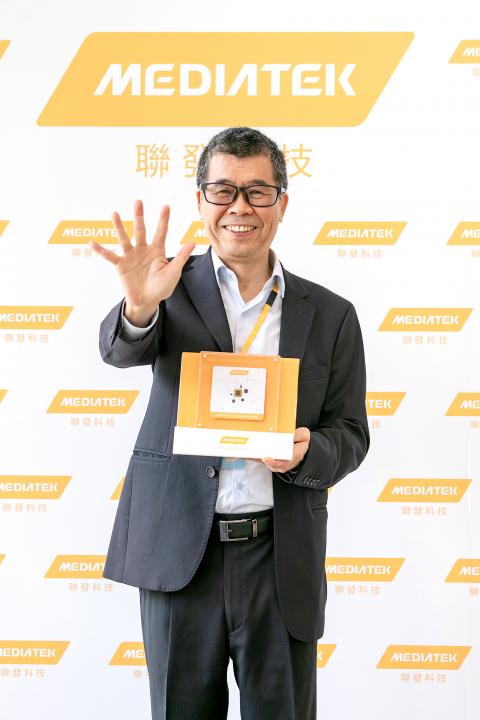Mobile phone chip designer MediaTek Inc (聯發科) yesterday said that it has invested NT$100 billion (US$3.23 billion) — part of which was spent on a team of 3,000 engineers — to grow its 5G technological capabilities and capture the market in its prime.
The company entered the mobile phone chip market in 2000, offering 2G chips.
As each new generation of wireless technology has been released since, the company has been striving to catch up with rivals such as Qualcomm Inc.

Photo: Cho Yi-chun, Taipei Times
Three years ago, the company started to allocate 20 to 30 percent of its annual research and development spending to 5G technology, MediaTek chief financial officer David Ku (顧大為) said, adding that the company budgeted between NT$50 billion and NT$60 billion per year for research and development.
“We will continue expanding our 5G team over time,” Ku said.
“Development of our 5G chips is going smoothly. Everything is on schedule,” he added.
MediaTek is scheduled release its first 5G single-chip product in the first quarter of next year, Ku said.
The chipmaker said it plans to release more details about the chip in December, which would be based on Taiwan Semiconductor Manufacturing Co’s (台積電) 7-nanometer technology.
That is just the first step, as MediaTek said it plans to launch a full series of 5G chips next year.
“MediaTek is definitely one of the leading 5G technology developers in the world,” MediaTek chairman Tsai Ming-kai (蔡明介) told reporters at the company’s headquarters in the Hsinchu Science Park (新竹科學園區), which houses the company’s new 5G fabs.
MediaTek estimated that 5G smartphone shipments would reach 140 million units next year, with the bulk, or 100 million phones, going to China, where MediaTek has built a stronghold over the years.
The company opened its 5G labs in Hsinchu Science Park yesterday, demonstrating to reporters mobile phone chips tested on equipment similar to the base stations used by North American and Japanese telecoms.
Commenting on a US-China trade dispute, MediaTek said that it would not benefit from the situation.
The company’s concern would be whether the trade dispute reduces consumers’ willingness to buy new smartphones, Ku said.

Taiwan Semiconductor Manufacturing Co (TSMC, 台積電) last week recorded an increase in the number of shareholders to the highest in almost eight months, despite its share price falling 3.38 percent from the previous week, Taiwan Stock Exchange data released on Saturday showed. As of Friday, TSMC had 1.88 million shareholders, the most since the week of April 25 and an increase of 31,870 from the previous week, the data showed. The number of shareholders jumped despite a drop of NT$50 (US$1.59), or 3.38 percent, in TSMC’s share price from a week earlier to NT$1,430, as investors took profits from their earlier gains

In a high-security Shenzhen laboratory, Chinese scientists have built what Washington has spent years trying to prevent: a prototype of a machine capable of producing the cutting-edge semiconductor chips that power artificial intelligence (AI), smartphones and weapons central to Western military dominance, Reuters has learned. Completed early this year and undergoing testing, the prototype fills nearly an entire factory floor. It was built by a team of former engineers from Dutch semiconductor giant ASML who reverse-engineered the company’s extreme ultraviolet lithography (EUV) machines, according to two people with knowledge of the project. EUV machines sit at the heart of a technological Cold

Taiwan’s long-term economic competitiveness will hinge not only on national champions like Taiwan Semiconductor Manufacturing Co. (TSMC, 台積電) but also on the widespread adoption of artificial intelligence (AI) and other emerging technologies, a US-based scholar has said. At a lecture in Taipei on Tuesday, Jeffrey Ding, assistant professor of political science at the George Washington University and author of "Technology and the Rise of Great Powers," argued that historical experience shows that general-purpose technologies (GPTs) — such as electricity, computers and now AI — shape long-term economic advantages through their diffusion across the broader economy. "What really matters is not who pioneers

TAIWAN VALUE CHAIN: Foxtron is to fully own Luxgen following the transaction and it plans to launch a new electric model, the Foxtron Bria, in Taiwan next year Yulon Motor Co (裕隆汽車) yesterday said that its board of directors approved the disposal of its electric vehicle (EV) unit, Luxgen Motor Co (納智捷汽車), to Foxtron Vehicle Technologies Co (鴻華先進) for NT$787.6 million (US$24.98 million). Foxtron, a half-half joint venture between Yulon affiliate Hua-Chuang Automobile Information Technical Center Co (華創車電) and Hon Hai Precision Industry Co (鴻海精密), expects to wrap up the deal in the first quarter of next year. Foxtron would fully own Luxgen following the transaction, including five car distributing companies, outlets and all employees. The deal is subject to the approval of the Fair Trade Commission, Foxtron said. “Foxtron will be